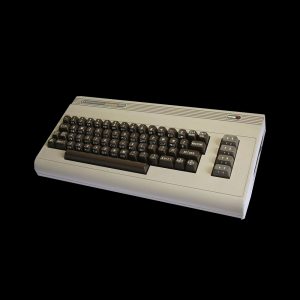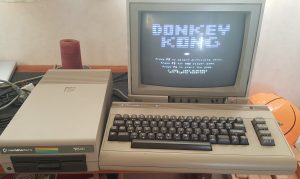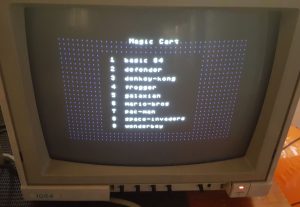
Commodore 64
Posted by musovern on Apr 20th, 2019 in Commodore | 0 comments
The Commodore 64 is an 8-bit home computer introduced by Commodore International in January 1982. Volume production started in the spring of 1982, with machines being released on to the market in August at a price of US $595.Preceded by the Commodore VIC-20 and Commodore MAX Machine, the C64 features 64KB (65,536 bytes) of memory with sound and graphics performance that were superior to IBM-compatible computers of that time. It is commonly known as the C64 or C=64 (after the graphic logo on the case) and occasionally as the CBM 64 (for Commodore Business Machines), or VIC-64. It has also been affectionately nicknamed the “breadbox” and “bullnose” due to the shape and color of the first version of its casing.
During the C64’s lifetime, sales totaled between 12.5 and 17 million units, making it the best-selling single personal computer model of all time. For a substantial period of time (1983–1986), the C64 dominated the market with between 30% and 40% share and 2 million units sold per year, outselling the IBM PC clones, Apple Inc. computers, and Atari 8-bit family computers. Sam Tramiel, a former Atari president and the son of Commodore’s founder, said in a 1989 interview “When I was at Commodore we were building 400,000 C64s a month for a couple of years.”
Part of its success was because it was sold in retail stores instead of electronics stores. Commodore produced many of its parts in-house to control supplies and cost. It is sometimes compared to the Ford Model-T automobile for its role in bringing a new technology to middle-class households via creative mass-production.
Approximately 10,000 commercial software titles were made for the Commodore 64 including development tools, office productivity applications, and games. Various C64 emulators allow anyone with a modern computer, or a compatible game console, to run these programs today. The machine is also credited with popularizing the computer demoscene|demo scene. The C64 is still used today by some computer hobbyists
Specifications
Internal hardware
Microprocessor CPU:
MOS Technology 6510|MOS Technology 6510/8500 (the 6510/8500 being a modified 6502 with an integrated 6-bit I/O port)
Clock speed: 0.985 MHz (PAL) or 1.023 MHz (NTSC)
Video: MOS Technology VIC-II 6567/8562 (NTSC), 6569/8565 (PAL)
16 colors
Text mode: 40*25 characters; 256 user-defined chars (8*8 pixels, or 4*8 in multicolor mode); 4-bit color RAM defines foreground color
Bitmap modes: 320*200 (2 unique colors in each 8*8 pixel block), 160*200 (3 unique colors + 1 common color in each 4*8 block)
8 hardware sprites of 24*21 pixels (12*21 in multicolor mode)
Smooth scrolling, raster interrupts
Sound: MOS Technology 6581/8580 SID
3-channel synthesizer with programmable ADSR envelope
8 octaves
4 waveforms per audio channel: triangle, sawtooth, variable pulse, noise
Oscillator synchronization, ring modulation
Programmable filter: high pass, low pass, band pass, notch filter
Input/Output: Two 6526 Complex Interface Adapters
16 bit parallel I/O
8 bit serial I/O
24-hours (AM/PM) Time of Day clock (TOD), with programmable alarm clock
16 bit interval timers
RAM:
64kB, of which 38kB (minus 1 byte) were available for BASIC programs
512 bytes color RAM (memory allocated for screen color data storage)
ROM:
20kB (9kB BASIC 2.0; 7kB Kernel; 4kB character generator, providing two 2kB character sets)
I/O ports and power supply
Commodore 64 ports (from left: Cartridge, RF-adj, RF, A/V, 488, Tape, User + Joy1, Joy2, Power)
I/O ports:
Cartridge expansion slot (slot for edge connector with 6510 CPU address/data bus lines and control signals, as well as GND and voltage pins; used for program modules and memory expansions, among others)
Integrated RF modulator antenna output via a RCA connector. The used channel could be adjusted from number 36 with the potentiometer to the left.
8-pin DIN connector containing composite video output, separate Y/C outputs and sound input/output. Beware that this is the 270° (horseshoe) version of the plug, not the 360° circular version. Also note that some early C64 units use a 5-pin DIN connector that carries composite video and luminance signals, but lacks a chroma signal.
Serial bus (serial version of IEEE-488, 6-pin DIN plug) for CBM printers and disk drives
PET-type Commodore Datassette 300 baud tape interface (edge connector with digital cassette motor/read/write/key-sense signals, Ground and +5V DC lines. The cassette motor is controlled by a +5V DC signal from the 6502 CPU. The 9 V AC input is transformed into unregulated 6.36 V DC which is used to actually power the cassette motor.
User port (edge connector with TTL-level signals, for modems etc.; byte-parallel signals which can be used to drive third-party parallel printers, among other things, 17 logic signals, 7 Ground and voltage pins, including 9V AC)
2 * screwless DE9M game controller ports (compatible with Atari 2600 controllers), each supporting five digital inputs and two analog inputs. Available peripherals included digital joysticks, analog paddles, a light pen, the Commodore 1351 mouse, and the unique KoalaPad.
Power supply:
5V DC and 9VAC from an external “power brick”, attached to a 7-pin female DIN-connector on the computer
Testing and running a few games.

Got a couple of PCB’s made to put games on instead of using Floppy Disks.


Leave a Reply